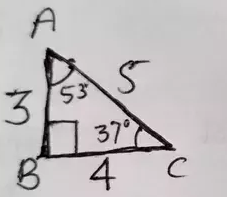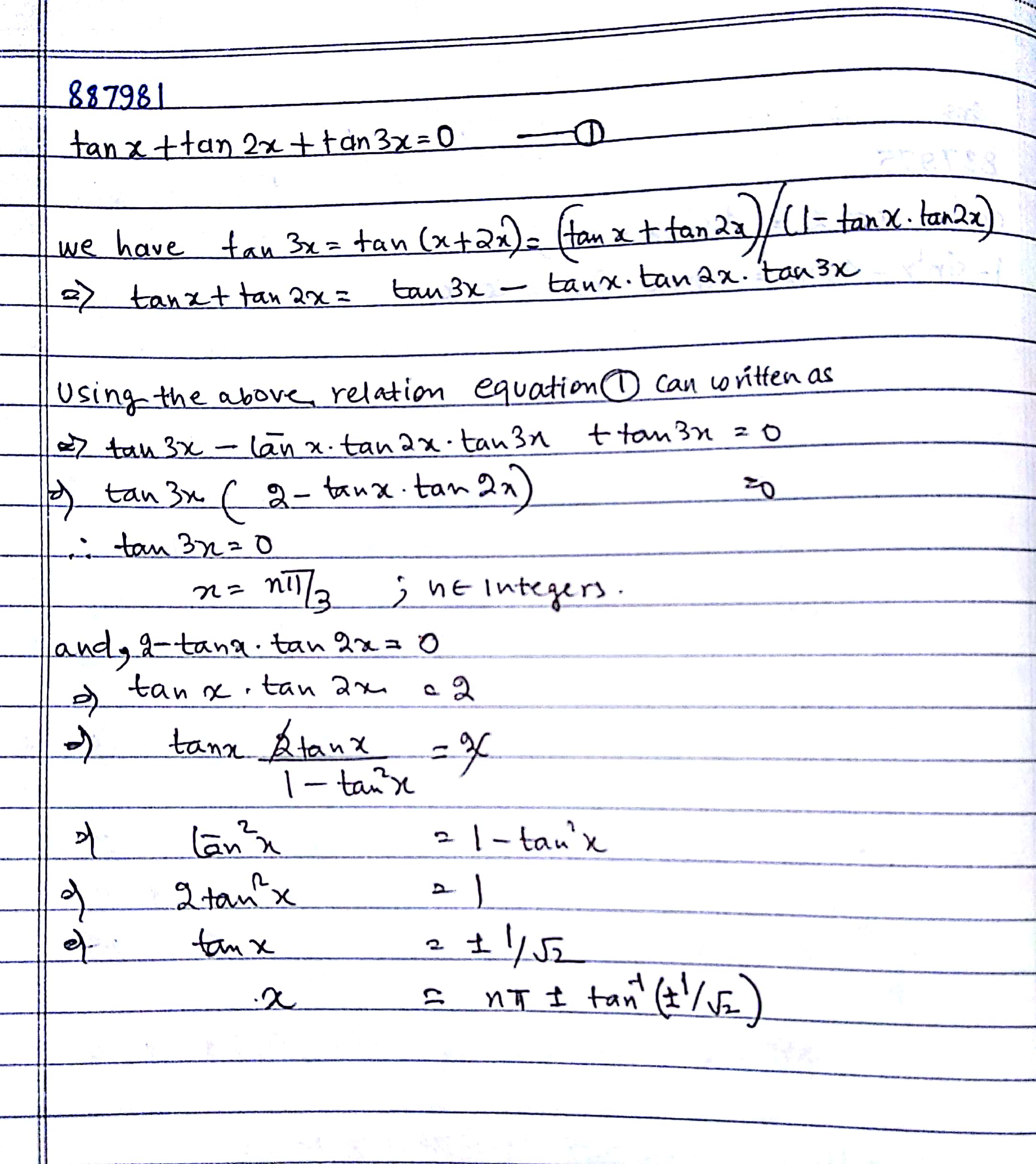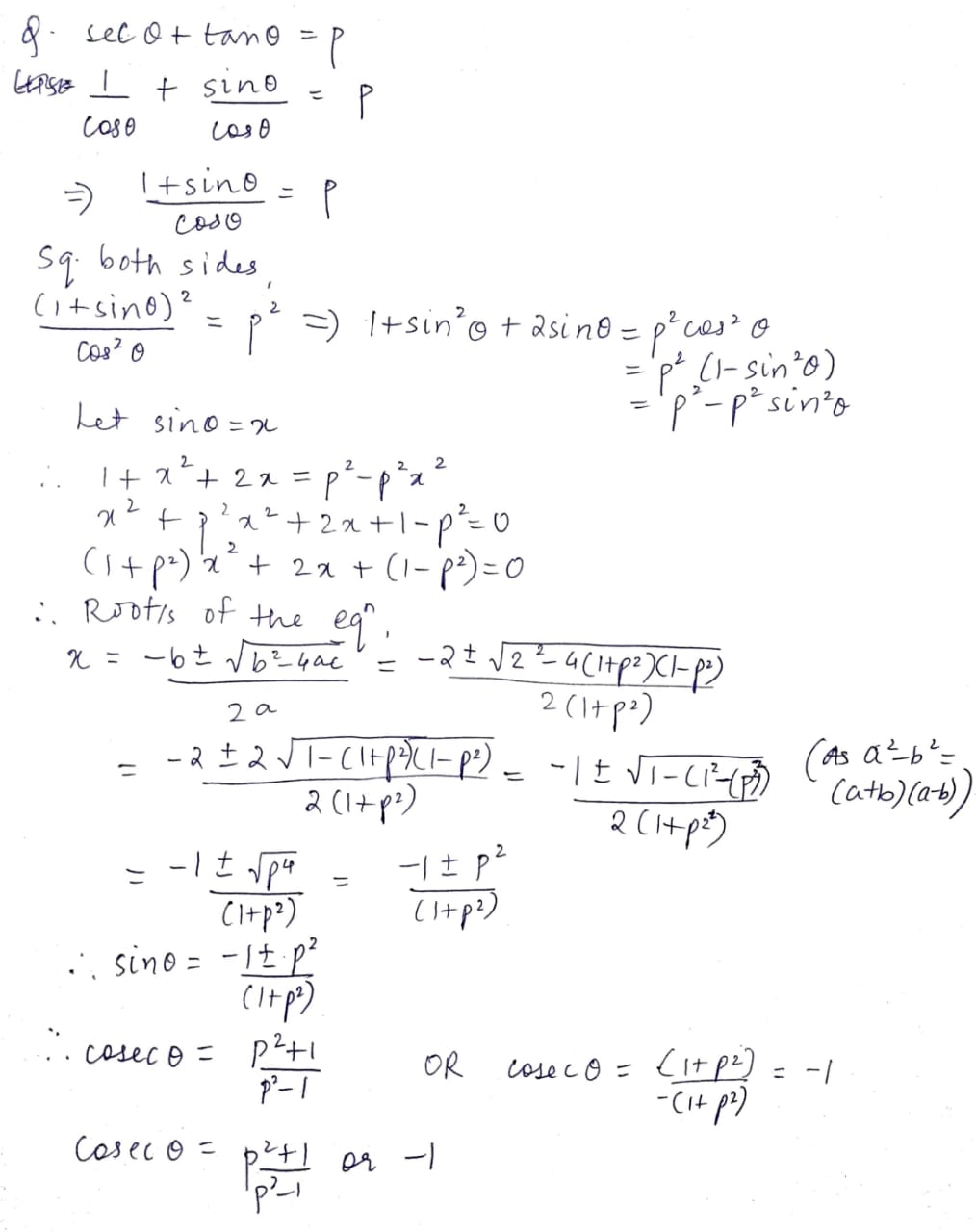Trigonometric Functions - Class 11 Commerce Maths - Extra Questions
$$\sin \theta =\cos \theta $$ for all values of $$\theta$$
Enter $$1$$ for true and $$0$$ for false
$$\cos{(A-B)}=$$
Convert $${ 25 }^{ 0 }$$ into Radian measure.
If $$7\sin ^{ 2 }{ x } +3\cos ^{ 2 }{ x } =4$$, show that $$\tan { x } =\dfrac { 1 }{ \sqrt { 3 } }$$
Solve$$\cos (A - B) - \cos (180 - (A + B)=0$$
The value of $$\cos \theta $$ increases as $$\theta $$ increases.
Enter $$1$$ for true and $$0$$ for false
Find the value of $$\theta$$ laying between 0 and $$\displaystyle \frac{\pi}{2}$$ and satisfying the equation
$$\begin{vmatrix}1 + \cos^2 \theta & \sin^2 \theta & 4 \sin 4 \theta \\ \cos^2 \theta & 1 + \sin^2 \theta & 4 \sin 4 \theta\\ \cos^2 \theta & \sin^2 \theta & 1 + 4 \sin 4 \theta\end{vmatrix} = 0$$.
If the value of $$\theta = \displaystyle \frac{a \pi}{b}$$, then find the value of $$\dfrac{(b-3)}a$$
If the value of $$\theta = \displaystyle \frac{a \pi}{b}$$, then find the value of $$\dfrac{(b-3)}a$$
If $$ \Delta = \begin{vmatrix}1 & sin \theta & 1\\ - sin \theta & 1 & sin \theta\\ -1 & -sin \theta & 1\end{vmatrix} ; 0 \leq \theta < 2 \pi$$ then $$\Delta \in [a,b]$$ Find $$\dfrac{b}{a}?$$
The general solution of $$\displaystyle 4\tan^{2}\theta=3\sec^{2}\theta$$ is $$\theta = n\pi\pm\dfrac{\pi}{m}$$. Then, find the value of $$m$$.
Solve $$\displaystyle \sin5x.\cos3x=\sin6x.\cos2x$$. then $$\displaystyle \frac{n\pi }{2},n\in I$$ or $$\displaystyle n\pi \pm \frac{\pi }{6},n\in I$$
If true then enter $$1$$ and if false then enter $$0$$
Solve $$\displaystyle \sin x+\cos x=\sqrt{2}$$, then $$x=\displaystyle 2n\pi +\frac{\pi }{4},n\in I$$
If true then enter $$1$$ and if false then enter $$0$$
Solve $$\displaystyle \sin x+\cos x=1+\sin x.\cos x$$, then $$2n\pi \pm \frac{\pi }{4}$$
If true then enter $$1$$ and if false then enter $$0$$
Find the general solution of the equation $$4\cos^{2} x = 1$$
Find the general solution of $$\cos x + \sin x = 1$$
If $$\alpha + \beta - \gamma = \pi$$, and $$\sin^{2} \alpha + \sin^{2}\beta - \sin^{2}\gamma = \lambda \sin \alpha \sin \beta \cos \gamma$$, then write the value of $$\lambda$$.
Find the domain of definition of the following function:
$$\displaystyle y \, = \, arc\cos \, \frac{2x \, + \, 1}{2 \, \sqrt{2x}}$$
How to calculate $$\sin { 37 } $$
Solve the following equation:
$$\displaystyle \tan \, x \, + \, \tan \, 2x \, + \, \tan \, 3x \, = \, 0$$
Prove that $$\cfrac { \sin { 9x } +\sin { 7x } +\sin { 5x } +\sin { 3x } }{ \cos { 9x } +\cos { 7x } +\cos { 5x } +\cos { 3x } } =\tan { 6x } $$
Prove that $$\sin(A-B)=\sin A \cos B-\cos A \sin B$$
Find the general solution of the following questions
$$ \cos x= 2x$$
$$ \sin 2x + \cos x=0$$.
Find the general solution for each of the following equation:
$$\sin 2x + \cos x = 0$$
Solve $$ \sin x+ \sqrt3 \cos x = \sqrt2$$
Prove that
If $$2 \, \sin \, \left(\theta + \dfrac{\pi}{3} \right) = \cos \left(\theta - \dfrac{\pi}{6} \right) \, then , \, \tan \theta + \sqrt{3} = 0$$
Prove: $$\dfrac{1 + sec \, A}{sec \, A } = \dfrac{sin^2 A}{1 - cos \, A}$$
If $$\cos (65^0-A)\cos(25^0+B)- \sin(65^0-A) \sin( 25^0+B)= \sin (m+A-B)$$.Find $$m$$
Convert the angles:
a) $$4.4^{c}$$
b) $$-\frac{9\pi}{2}^{c}$$
into degree.
$$ifsec\theta +tan\theta =p\quad then\quad the\quad value\quad of\quad cosec\theta $$
Class 11 Commerce Maths Extra Questions
- Binomial Theorem Extra Questions
- Complex Numbers And Quadratic Equations Extra Questions
- Conic Sections Extra Questions
- Limits And Derivatives Extra Questions
- Permutations And Combinations Extra Questions
- Probability Extra Questions
- Relations And Functions Extra Questions
- Sequences And Series Extra Questions
- Sets Extra Questions
- Straight Lines Extra Questions
- Trigonometric Functions Extra Questions


